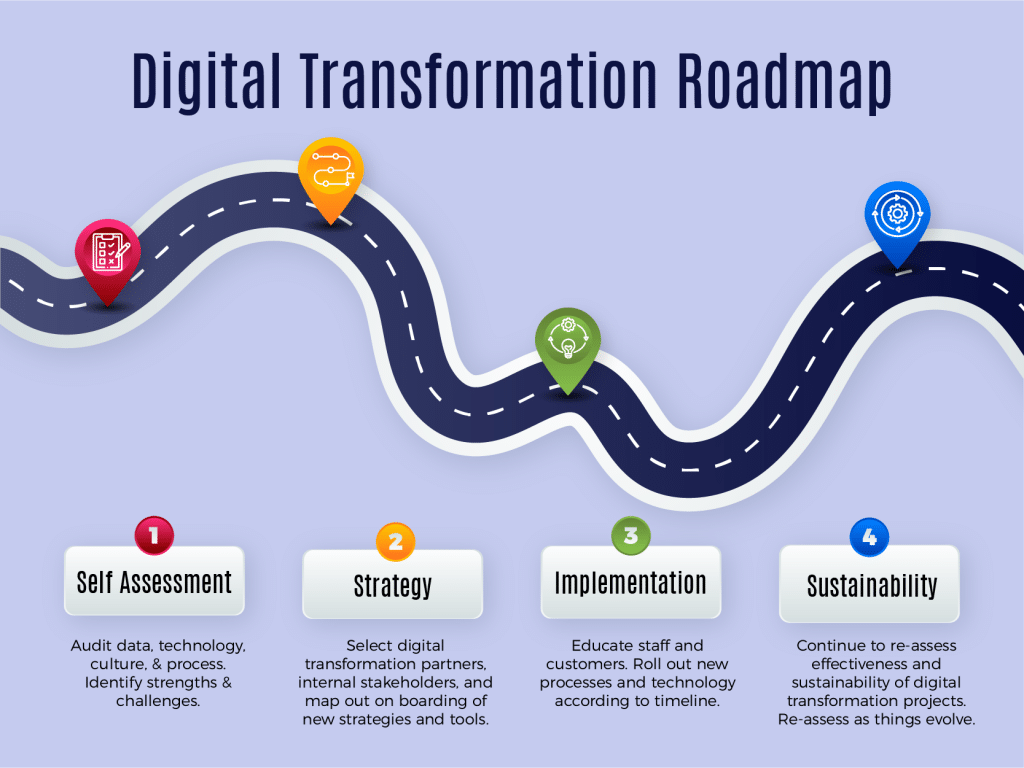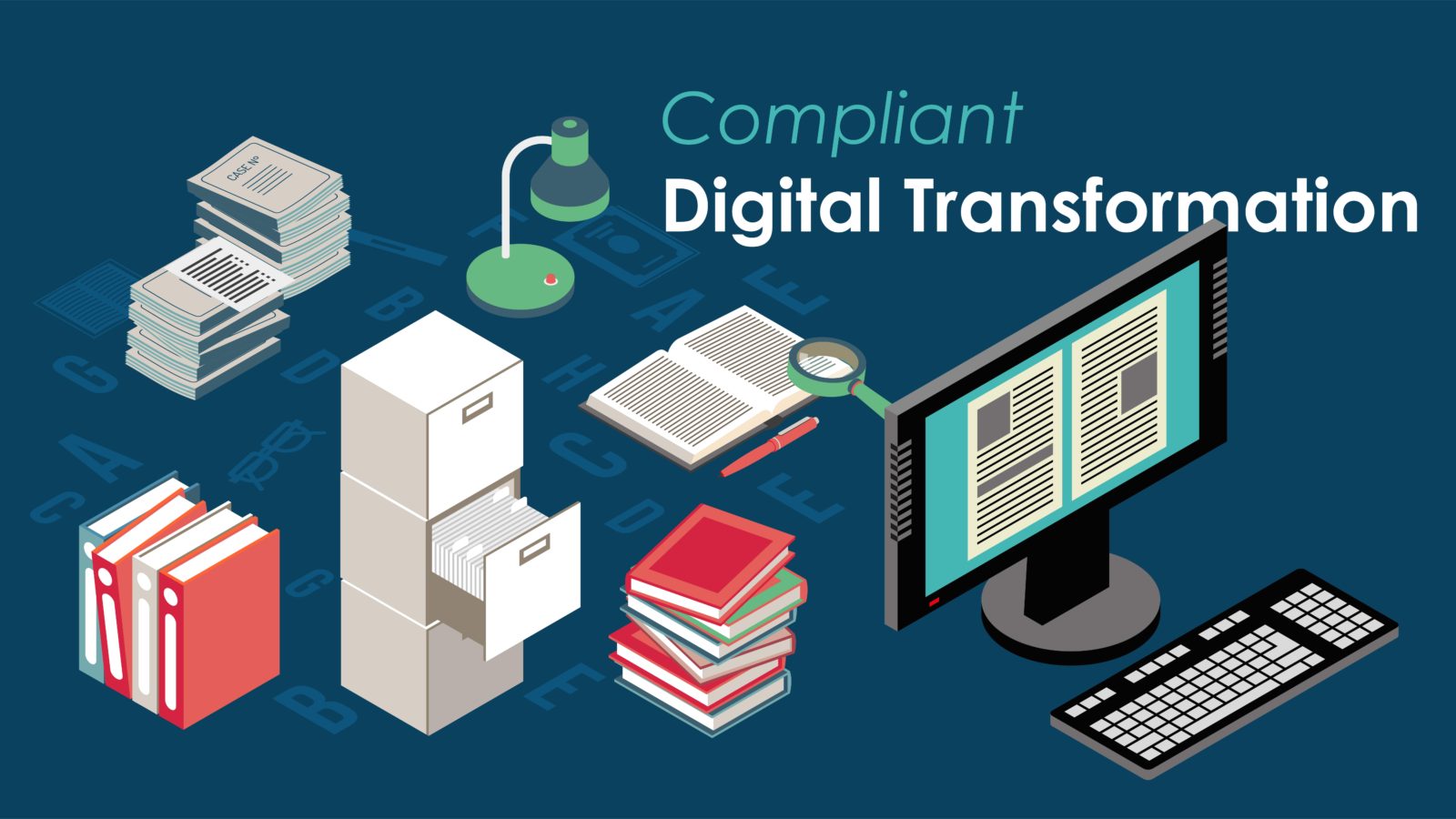The Basics of Building a Digital Transformation Roadmap
Where do you start when building a Digital Transformation Roadmap?
November 16, 2021
Digital transformation may seem like a daunting undertaking but it doesn’t have to be. This blog will offer a quick outline of four key elements you should consider in your transformation as well as the four stages of your transformation.
What Should be Covered by a Digital Transformation Roadmap
Every organization has different challenges and goals, but in general there are four areas that you should focus on when building your modernization plan – data, technology, culture, and process. There may be some nuanced areas you need to explore such as compliance, market requirements, or customer needs, but these four categories provide a great foundation for any transformation roadmap.
Data:
Good data drives change. Data should be a key part of your digital transformation strategy because it helps you track what is working and what isn’t. If you’re not collecting and analyzing data surrounding your products and services you’ve got a serious blindspot. Collecting the right data will help you determine where you need to apply new technology and re-think processes that aren’t working. If you’re not already collecting and using data effectively adding in a new data platform may be something to consider as a part of your transformation project.
Technology
This might include new software, hardware, or automation tools. Tech is the first thing most people think of when they consider digital transformation. However, as exciting as onboarding new tech can be, it’s not effective when implemented without the cultural changes needed to make it sustainable. Choose your technology wisely – picking cloud-based tools will mean better longevity and scalability than legacy software or on-site data storage.
Culture
Corporate culture is an often overlooked part of digital transformation. Without buy in from the team, no digital transformation project can succeed. Finding the right next steps means assessing your culture and choosing initiatives that fit both your working style and goals. Keeping your staff involved in the process is essential. Taking the time to educate your team about changes and get meaningful feedback will smooth out some of the bumps in the road as you evolve.
Process
Changing your processes isn’t as flashy as onboarding a fancy new software but it can be just as effective. Sometimes small shifts ripple into big impacts in terms of cost savings and increased efficiency.
Culture
Corporate culture is an often overlooked part of digital transformation. Without buy in from the team, no digital transformation project can succeed. Finding the right next steps means assessing your culture and choosing initiatives that fit both your working style and goals. Keeping your staff involved in the process is essential. Taking the time to educate your team about changes and get meaningful feedback will smooth out some of the bumps in the road as you evolve.
Process
Changing your processes isn’t as flashy as onboarding a fancy new software but it can be just as effective. Sometimes small shifts ripple into big impacts in terms of cost savings and increased efficiency.
Building your Roadmap:
There are many approaches to digital transformation and every organization’s approach will be different, but generally a modernization journey consists of four stages:
- Self-Assessment
- Strategy
- Implementation
- Re-Assessment | Sustainability
The following section will break down these four stages to give you a basic understanding of what goes into the cyclical process of transformation.

Stage One: Self-Assessment
The first step in the process of transforming your organization is to conduct a thorough self assessment. Auditing your data, technology, culture, and processes will give you the information needed to change strategically. Many organizations get bogged down in this process because they don’t know how to really analyze what is and isn’t working. This is a great opportunity to bring in a trusted digital transformation parter. Often an outside perspective is what’s needed to really identify silos or areas where change is needed.
Stage Two: Strategy
Once you’ve identified the strengths, weaknesses, and opportunities for you organization through a self-assessment you can begin to develop a strategy. However, it’s important not to change things just for the sake of change. At this step in the process you will want to define meaningful and trackable goals, but you’ll also want to have a larger vision for what digital transformation will mean for your team. This might look like a vision to serve your customers better with trackable goals such as faster response times and better insight into the customer buying cycle.
In any case, your strategy should address each of the areas you assessed in step one, and lay out a timeline for the adoption of any new technology or processes. Digital transformation is not an end goal, it’s ongoing so you will need to strike a balance between forward momentum and sustainability. If you apply changes too quickly or before fully educating your team then it’s unlikely these changes will take hold. People are at the heart of modernization – both your customers and your staff and so accounting for the human element is key. This may mean adopting new technology in stages so your staff can adapt or improving your customer communication strategy to prepare them for any new processes.
Stage Three: Implementation
his is the most exciting part of digital transformation, but also the most treacherous. You can strategize and plan for years and still encounter unexpected challenges when you reach the implementation stage. Maintaining a flexible approach will help ease the transition but the truth is implementation can be still messy.
As you onboard new technology and processes your organization may struggle with the learning curve. This is where your people and partners really have an opportunity to make an impact. Identifying and assigning the right people to oversee your transformation, effectively training staff, and choosing the right digital service providers minimizes hiccups.
Stage Four: Re-Assessment & Sustainability
Digital transformation should be sustainable, this means that your changes should be long-lasting and forward thinking. This means doing your best to choose tools and strategies that will scale with your business and won’t become obsolete too quickly. Going through the expense and effort of onboarding a new software only for it to become outmoded within a couple of years can result a lot of wasted resources. For that reason we recommend choosing cloud tools over legacy software and finding vendors that can scale with you as you grow.
After you’ve implemented your digital transformation project you’ll want to ensure you’re tracking it’s success by collecting the right data. Continuing to re-assess the success of your projects and keep a pulse on the health of your organization will make the next cycle of your evolution easier.
Can DOMA Help me With Digital Transformation.
DOMA Technologies is an experienced digital solutions provider for a wide range of transformative cloud technologies. Whether you’re just getting started with digital services such as document scanning or looking to implement more advanced automation and AI tools, we are here to answer any questions you may have.
About DOMA- Powered by Tech, Driven by People
DOMA Technologies (DOMA) is a software development and digital transformation company whose mission is to change customer lives by lightening their workload through faster and more targeted access to their data. Since 2000, our team of 200+ experts has helped businesses navigate all aspects of the digital world. We are a dedicated strategic partner for the federal government and private sector clients at every stage of their unique digital transformation journey.

Author:
Danielle Wethington
Director of Communications
Digital Transformation
Learn more about DOMA’s Digital Transformation
Recent News

DX Engage Achieves FedRAMP Ready Status

Data-Driven Sustainability for a Healthier Future

Humanizing Healthcare

